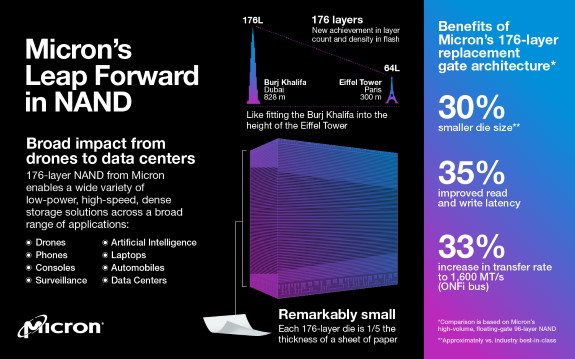
Volume production has already started, Micron says its using the 176-layer NAND flash memory for some new (but unidentified) Crucial SSDs. More products are expected in 2021.

Micron Technology, Inc. (Nasdaq: MU), today announced that it has begun volume shipments of the world’s first 176-layer 3D NAND flash memory, achieving unprecedented, industry-pioneering density and performance. Together, Micron’s new 176-layer technology and advanced architecture represent a radical breakthrough, enabling immense gains in application performance across a range of storage use cases spanning data center, intelligent edge and mobile devices.
“Micron’s 176-layer NAND sets a new bar for the industry, with a layer count that is almost 40% higher than our nearest competitor’s,” said Scott DeBoer, executive vice president of technology and products at Micron. “Combined with Micron’s CMOS-under-array architecture, this technology sustains Micron’s industry cost leadership.”
Representing Micron’s fifth generation of 3D NAND and second-generation replacement-gate architecture, Micron’s 176-layer NAND is the most technologically advanced NAND node in the market. Compared with the company’s previous generation of high-volume 3D NAND, Micron’s 176-layer NAND improves both read latency and write latency by more than 35% — dramatically accelerating application performance. Featuring approximately 30% smaller die size than best-in-class competitive offerings, Micron’s 176-layer NAND’s compact design is ideal for solutions using small form factors.
Groundbreaking technology arms diverse markets with the fullest power of flash
“Micron’s 176-layer NAND enables breakthrough product innovation for our customers,” said Sumit Sadana, executive vice president and chief business officer at Micron. “We are deploying this technology across our broad product portfolio to bring value everywhere NAND is used, targeting growth opportunities in 5G, AI, cloud and the intelligent edge.”
With its versatile design and unrivaled density, Micron’s 176-layer NAND serves as an essential building block in technologists’ toolboxes across a broad array of sectors, including mobile storage, autonomous systems, in-vehicle infotainment, and client and data center solid-state drives (SSDs).
Micron’s 176-layer NAND offers improved quality of service (QoS), a critical design criterion for data center SSDs. This can accelerate data-intensive environments and workloads such as data lakes, artificial intelligence (AI) engines and big data analytics. For 5G smartphones, the enhanced QoS can enable faster launching and switching across multiple apps, creating a more seamless and responsive mobile experience and enabling true multitasking and full use of 5G’s low-latency network.
Micron’s fifth generation of 3D NAND also features an industry-leading maximum data transfer rate at 1,600 megatransfers per second (MT/s) on the Open NAND Flash Interface (ONFI) bus, a 33% improvement. The increased ONFI speed leads to faster system bootup and application performance. In automotive applications, this speed will power near instant-on response times for in-vehicle systems as soon as engines are turned on, enhancing the user experience.
Micron is working with industry developers to quickly integrate the new products into solutions. To simplify firmware development, Micron’s 176-layer NAND offers a single-pass programming algorithm, enabling easier integration and speeding time to market.
Micron achieves unparalleled density and cost leadership with novel architecture
With the slowing of Moore’s Law, Micron’s innovation in 3D NAND is critical to ensuring that the industry can keep pace with growing data requirements. To achieve this milestone, Micron has uniquely combined its stacked replacement-gate architecture, novel charge-trap and CMOS-under-array (CuA) techniques. Micron’s team of 3D NAND experts achieved rapid advancements with the company’s proprietary CuA technique, which constructs the multilayered stack over the chip’s logic — packing more memory into a tighter space and substantially shrinking the 176-layer NAND’s die size, yielding more gigabytes per wafer.
In tandem, Micron has improved scalability and performance for future NAND generations by transitioning its NAND cell technology from legacy floating gate to charge-trap. This charge-trap technology is combined with Micron’s replacement-gate architecture, which uses highly conductive metal wordlines instead of a silicon layer to achieve unparalleled 3D NAND performance. Micron’s adoption of this technology will also enable the company to drive aggressive, industry-leading cost reductions.
Applying these advanced techniques, Micron has increased endurance, which is particularly beneficial in write-intensive use cases — from black boxes in aerospace to video surveillance recording. In mobile storage, 176-layer NAND’s replacement-gate architecture results in 15% faster mixed workload performance to power ultra-fast edge computing, enhanced AI inference, and graphic-rich, real-time multiplayer gaming.
Availability
Micron’s 176-layer triple-level cell 3D NAND is in volume production in Micron’s Singapore fab and now shipping to customers, including through its Crucial consumer SSD product lines. The company will introduce additional new products based on this technology during calendar 2021.